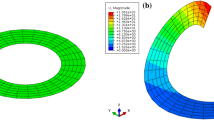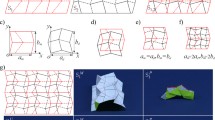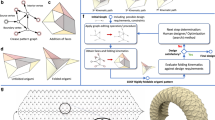Abstract
Most existing treatments for origami-folding simulations have focused on regular-shaped configurations. This article aims to introduce a general strategy for simulating and analyzing the deformation process of irregular shapes by means of computational capabilities nowadays. To better simulate origami deformation with folding orders, the concept of plane follow-up is introduced to achieve automated computer simulation of complex folding patterns, thereby avoiding intersection and penetration between planes. Based on the evaluation criteria such as the lowest storage energy with tightening and the fastest pace from tightening to unfolding, the optimal crease distribution patterns for four irregular (‘N’-, ‘T’-, ‘O’-, and ‘P’-shaped) origami configurations are then presented under five candidates. When the dimensions of the origami are fixed, it is discovered that simpler folding patterns lead to faster deformation of the origami configuration. When the folding complexity is fixed, higher strain energy results in more rapid origami expansion.






Similar content being viewed by others
Data Availability
The data and material used or analyzed during the current study are available from the corresponding authors upon reasonable requests.
References
Zirbel SA, Lang RJ, Thomson MW, Sigel DA, Walkemeyer PE, Trease BP, Magleby SP, Howell LL. Accommodating thickness in origami-based deployable arrays. J Mech Des. 2013;135(11):111005.
Wilson L, Pellegrino S, Danner R. Origami sunshield concepts for space telescopes. In: 54th AIAA/ASME/ASCE/AHS/ASC structures. Structural dynamics, and materials conference. 2013; p. 1594.
Landau E. Solar power, origami-style. https://www.jpl.nasa.gov/news/solar-power-origami-style. 2014.
Holland A, Straub J. Development of origami-style solar panels for use in support of a mars mission. In: Energy harvesting and storage: Materials, devices, and applications VII. International Society for Optics and Photonics. 2016; 9865: 72–7.
Morgan J, Magleby SP, Howell LL. An approach to designing origami-adapted aerospace mechanisms. J Mech Des. 2016;138(5):052301.
Badagavi P, Pai V, Chinta A. Use of origami in space science and various other fields of science. In: 2017 2nd IEEE international conference on recent trends in electronics, information & communication technology (RTEICT). 2017; p. 628–32.
Wu R, Roberts PCE, Soutis C, Diver C. Heliogyro solar sail with self-regulated centrifugal deployment enabled by an origami-inspired morphing reflector. Acta Astronaut. 2018;152:242–53.
Rus D, Tolley MT. Design, fabrication and control of origami robots. Nat Rev Mater. 2018;3(6):101–12.
Cromvik C. Numerical folding of airbags based on optimization and origami. Chalmers Tekniska Hogskola (Sweden). 2007.
Bruton J, Nelson TG, Zimmerman T, Fernelius JD, Magleby SP, Howell LL. Packing and deploying soft origami to and from cylindrical volumes with application to automotive airbags. Royal Soc Open Sci. 2016;3(9):160429.
Mroz K, Pipkorn B. Mathematical modelling of the early phase deployment of a passenger airbag–folding using origami theory and inflation using ls-dyna particle method. In: Sixth European LS-DYNA users conference. 2007.
Salerno M, Zhang K, Menciassi A, Dai JS. A novel 4-dofs origami enabled, sma actuated, robotic end-effector for minimally invasive surgery. In: 2014 IEEE international conference on robotics and automation (ICRA). 2014; pp. 2844–2849.
Balkcom DJ, Mason MT. Robotic origami folding. Carnegie Mellon University. 2004.
Xu S. Pouch motors: Printable pneumatic actuators for foldable robotics. PhD thesis. Massachusetts Institute of Technology. 2015.
Miura K. Map fold a la miura style, its physical characteristics and application to the space science. Res Pattern Form. 1994; 77–90.
Chen Y, Feng HJ, Ma JY, Peng R, You Z. Symmetric waterbomb origami. Proc Royal Soc A Math Phys Eng Sci. 2016;472(2190):20150846.
Cai J, Deng X, Zhou Y, Feng J, Tu Y. Bistable behavior of the cylindrical origami structure with kresling pattern. J Mech Des. 2015;137(6):061406.
Cai J, Deng X, Xu Y, Feng J. Motion analysis of a foldable barrel vault based on regular and irregular yoshimura origami. J Mech Robot. 2016;8(2):021017.
Jun H, Zhang F, Shepherd T, Ratanalert S, Qi X, Yan H, Bathe M. Autonomously designed free-form 2d dna origami. Sci Adv. 2019;5(1):0655.
Zhao Y, Kanamori Y, Mitani J. Design and motion analysis of axisymmetric 3d origami with generic six-crease bases. Comput Aided Geom Design. 2018;59:86–97.
Dong ZC, Guo X, Zhu YC. Origami discovery by means of digital resources. Extreme Mech Lett. 2022;57:101916.
Nauroze SA, Novelino LS, Tentzeris MM, Paulino GH. Continuous-range tunable multilayer frequency-selective surfaces using origami and inkjet printing. Proc Natl Acad Sci. 2018;115(52):13210–5.
Zhu Y, Filipov ET. Rapid multi-physics simulation for electro-thermal origami systems. Int J Mech Sci. 2021;202:106537.
Hathcock M, Popa BI, Wang KW. Origami inspired phononic structure with metamaterial inclusions for tunable angular wave steering. J Appl Phys. 2021;129(14):145103.
Schenk M, Guest SD, et al. Origami folding: A structural engineering approach. Origami. 2011;5:291–304.
Wei ZY, Guo ZV, Dudte L, Liang HY, Mahadevan L. Geometric mechanics of periodic pleated origami. Phys Rev Lett. 2013;110(21):215501.
Liu K, Paulino GH. Nonlinear mechanics of non-rigid origami: an efficient computational approach. Proc Royal Soc A Math, Phys Eng Sci. 2017;473(2206):20170348.
Zhu Y, Schenk M, Filipov ET. A review on origami simulations: From kinematics, to mechanics, toward multiphysics. Appl Mech Rev. 2022;74(3):030801.
Qiu C, Zhang K, Dai JS. Repelling-screw based force analysis of origami mechanisms. J Mech Robot. 2016;8(3):031001.
Brunck V, Lechenault F, Reid A, Adda-Bedia M. Elastic theory of origami-based metamaterials. Phys Rev E. 2016;93(3):033005.
McGough K, Ahmed S, Frecker M, Ounaies Z. Finite element analysis and validation of dielectric elastomer actuators used for active origami. Smart Mater Struct. 2014;23(9):094002.
Yang K, Xu SQ, Shen JH, Zhou SW, Xie YM. Energy absorption of thin-walled tubes with pre-folded origami patterns: Numerical simulation and experimental verification. Thin-Walled Struct. 2016;103:33–44.
Gattas JM, You Z. Quasi-static impact of indented foldcores. Int J Impact Eng. 2014;73:15–29.
Silverberg JL, Evans AA, Mcleod L, Hayward RC , Hull T, Santangelo CD, Cohen I. Using origami design principles to fold reprogrammable mechanical metamaterials. Science. 2014;345(6197):647–50.
Bowen L, Springsteen K, Feldstein H, Frecker M, Simpson TW, Lockette PV. Development and validation of a dynamic model of magneto-active elastomer actuation of the origami waterbomb base. J Mech Robot. 2015;7(1):011010.
Liu K, Paulino GH, Merlin: A matlab implementation to capture highly nonlinear behavior of non-rigid origami. In: Proceedings of IASS annual symposia. International association for shell and spatial structures (IASS). 2016
Filipov ET, Liu K, Tachi T, Schenk M, Paulino GH. Bar and hinge models for scalable analysis of origami. Int J Solids Struct. 2017;124:26–45.
Woodruff SR, Filipov ET. A bar and hinge model formulation for structural analysis of curved-crease origami. Int J Solids Struct. 2020;204:114–27.
Li ST, Kang XD, Fang LY, Hu JW, Yin HT. Pixel-level image fusion: A survey of the state of the art. Information Fusion. 2017;33:100–12.
Funding
The work is supported by the National Natural Science Foundation of China 11821202 (Xu Guo), the National Key Research and Development Plan 2020YFB1709401 (Xu Guo), and the Liaoning Revitalization Talents Program XLYC2001003 (Xu Guo).
Author information
Authors and Affiliations
Contributions
ZD, YZ, and XG designed the study; ZD performed the research and conducted experiments; ZD drafted the article; all authors contributed to the revisions.
Corresponding author
Ethics declarations
Conflict of interest
The authors declare that they have no competing interests.
Ethical approval and consent to participate
This article does not contain any studies with human participants or animals performed by any of the authors.
Consent for publication
Consent for publication has been obtained from all individual participants included in the study.
Supplementary Information
Below is the link to the electronic supplementary material.


Rights and permissions
Springer Nature or its licensor (e.g. a society or other partner) holds exclusive rights to this article under a publishing agreement with the author(s) or other rightsholder(s); author self-archiving of the accepted manuscript version of this article is solely governed by the terms of such publishing agreement and applicable law.
About this article
Cite this article
Dong, Z., Zhu, Y. & Guo, X. A General Simulation Method for Complex Deformation of Irregular-Shaped Origami Configurations. Acta Mech. Solida Sin. 37, 90–98 (2024). https://doi.org/10.1007/s10338-023-00443-7
Received:
Revised:
Accepted:
Published:
Issue Date:
DOI: https://doi.org/10.1007/s10338-023-00443-7




